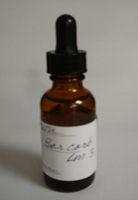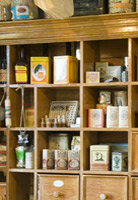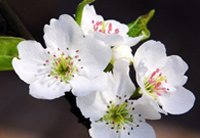What Are Homeopathic Remedies?
The "medicines" used in homeopathy are called remedies. They can be made from just about any substance known to man, including plants, minerals, animal products, and energy fields. More than 5,000 substances have been prepared and "proven." Examples range from mercury to mistletoe to calcium carbonate to dolphin milk to light spectrum (a rainbow). They are FDA approved.
What is proving?
 Homeopathic research is conducted through the process of a proving, which determines the curative properties of a substance by observing and cataloging its effects. The proving process involves giving substances to healthy individuals and observing and recording symptoms, unusual sensations, and alterations from normal health, including what makes each of these better or worse
Homeopathic research is conducted through the process of a proving, which determines the curative properties of a substance by observing and cataloging its effects. The proving process involves giving substances to healthy individuals and observing and recording symptoms, unusual sensations, and alterations from normal health, including what makes each of these better or worse
This is what Hahnemann, the founder of homeopathy, did when he took cinchona bark (quinine). He found that by taking doses of cinchona, which was already the treatment of choice for malaria in those days, he went on to develop the symptoms of malaria himself-fever, chills, sweats, and body pains that he documented in detail. (This was the classic example of "like treats like.")
Once a substance is proven, it is used to treat people who have the same symptoms as those produced by the substance in healthy individuals. For example, people who develop symptoms of malaria take a remedy made from cinchona. If a person with specific symptoms takes the right homeopathic remedy, their system will correct, and the existing symptoms end.
How are remedies made?
Substances become remedies through a very specific process called "potentization," which involves sequential dilution and succussion, which is a hard pounding or shaking.
This preparation process occurs as follows:
- To begin, the substance is dissolved or finely ground into a double-distilled water/alcohol mix or milk sugar.
- The initial dilution is one part substance to 10 parts water/alcohol (1:10 or 1X), or one part to substance to 100 parts water/alcohol (1:100 or 1C) or one part substance to 1,000 parts water/alcohol (1:1000 or 1M).
- The solution is succussed (shaken or pounded), then a drop of the solution is diluted again 1:10 or 1:100 or 1:1,000.
- The process is repeated as many times as necessary to achieve the desired potency.
- If the final product is in a water/alcohol mix, it is then sprayed on pellets of milk sugar, which act as a carrier for the remedy.
A somewhat different process of diluting 1:50,000 is used to create remedies in a form called LM, which are kept in liquid form and often administrated daily. We will not speak in detail about those remedies in this module.
How are remedies labeled?
Remedies are labeled by the ratio of dilution and the number of times diluted. Such labeling helps to discriminate a homeopathic remedy from an herbal or mineral supplement. In this process, a substance may be repetitively diluted 1:10 (labeled X scale) or 1:100 (labeled C scale) or 1:1,000 (labeled M scale). Then the number of times it is diluted and succussed is noted, e.g. 12X, 30C, 10M.
The fascinating and scientifically confusing thing about homeopathic remedies is that the more diluted they are, the stronger they become-that is, potentized. In chemistry, there is a concept of how many molecules of a substance are present in a defined solution (it is called one gram mole). This is called Avogadro's number, and it is 6.023 x 1023 . Therefore, if you dilute a solution 1 to 10, twenty-four times, or 1 to 100, twelve times, there cannot be any molecules of the original substance left! That is why homeopathy is considered a process that works through "sub-molecular" interventions.
Potency Dilution 1X 1:10 2X 1:100 6X 1:1 million 12X 1:1 trillion 12C 1:1x10^24
With homeopathic remedies, the higher the dilution, the less "material" in the remedy and the stronger the energy appears to be. Lower dilutions may still have some material in them and work more on the physical plane, while higher dilutions seem to work more on the mental and emotional planes, and are often observed to result in deeper and longer lasting effects. Because of this, remedies in the range of up to 30C are considered low potencies, while those of 200C or above are considered high potencies.
How do people use remedies?
Homeopathic remedies can be used in several different ways.
- In an acute, or first aid, setting, low potency remedies may be administered frequently and repetitively, depending upon the situation (this is best guided by a skilled prescriber or at least an informed consumer).
 In contrast, when a classical homeopath recommends a remedy for a client, he or she identifies the one best remedy for the overall health and symptom state of a person, taking into account the full range of physical, mental, emotional, and spiritual states of the person. The homeopath gives the remedy once in a single dose, then monitors responses for weeks to months. This is called constitutional treatment in classical homeopathy.
In contrast, when a classical homeopath recommends a remedy for a client, he or she identifies the one best remedy for the overall health and symptom state of a person, taking into account the full range of physical, mental, emotional, and spiritual states of the person. The homeopath gives the remedy once in a single dose, then monitors responses for weeks to months. This is called constitutional treatment in classical homeopathy.- A variation of dosing uses liquid LM remedies. Homeopaths usually recommend dosing once or twice daily. Part of the dosing process with LMs is to succuss and dilute further, so that each subsequent dose is slightly more potent and stimulates the healing response. An individual's constitutional LM may also be used to treat an acute illness.
- For common complaints, such as colds, coughs, flus, earaches, and teething, a consumer may purchase homeopathic products over the counter. Examples of such products are Zicam for allergies and NoJetLag. Most of these are combination products made up of many low potency remedies, acting in a "shotgun" approach to the particular symptom(s). Used in the short term, these probably have no lasting negative impact, but if taken for prolonged periods of time, the remedies that were not suited to the particular individual can begin to cause "proving" symptoms in that person (see explanation above). These should resolve upon stopping ingestion of the product. Because of this issue, single remedy therapies are usually most ideal and less likely to cause undesired effects.
Where can I buy remedies?
 The FDA regulates the manufacturing and distribution of homeopathic remedies, as it does over-the-counter pharmaceuticals. And like over-the-counter pharmaceuticals, you can buy single remedies in lower potencies (usually 12X or 30C) without a prescription at health food stores and co-ops, progressive drug stores, and some grocery stores.
The FDA regulates the manufacturing and distribution of homeopathic remedies, as it does over-the-counter pharmaceuticals. And like over-the-counter pharmaceuticals, you can buy single remedies in lower potencies (usually 12X or 30C) without a prescription at health food stores and co-ops, progressive drug stores, and some grocery stores.
Most higher potency remedies must be obtained directly through a homeopath who stocks their own remedies, or through a homeopathic pharmacy (see Where Can I Get More Information? on left). For remedies made from any prescription drug or controlled substance, a licensed prescriber must write a prescription to obtain the substance from a homeopathic pharmacy. For example, morphine, a pain medicine available by prescription that causes sedation and mental dullness, may be used homeopathically for someone in a very sedated and drowsy state.
Homeopathic remedies are very inexpensive, especially compared to most prescription pharmaceuticals. Depending upon potency and volume, they may range from $8 to $25 for most readily available remedies.
Remedies are best cared for in a relatively temperature-stable environment, protected from extensive direct light, therefore bottles should be darkened or opaque. They appear to last indefinitely when well cared for.
Are flower essences part of homeopathy?
Flower essences are therapeutic products that are made from plants in a way that conveys the energetic information from that plant. They are energetic imprints of the life force of plants that interact with the subtle bodies of humans and evoke specific qualities within us. Like a homeopathic remedy, they do not work on a material or molecular basis. Therefore, a flower essence is not an herbal product, in the usual sense of the word.
 Flower essences are infusions, usually made by placing the peak flower of the plant into glass containers holding distilled water for about three hours. The flowers are then discarded, and the water preserved in brandy. This is the "mother tincture" from which the Bach Flower Essences are prepared.
Flower essences are infusions, usually made by placing the peak flower of the plant into glass containers holding distilled water for about three hours. The flowers are then discarded, and the water preserved in brandy. This is the "mother tincture" from which the Bach Flower Essences are prepared.
The first 38 flower remedies were formulated by a British physician, Dr. Edward Bach, in the 1930s, although new remedies from other plant species are now available. The Flower Essence Society and other organizations have now tested and developed many other lines of flower essences.
The theory is that each flower embodies a particular soul quality (or energy frequency). When an individual is out of touch with that aspect of his or her fundamental nature, flower essences can be used to restore that quality. Flower essences thus address spiritual, emotional, and mental aspects of wellness. Flower essences may be used by some homeopathic prescribers and may sometimes be used in combination with each other and with homeopathic remedies.
References and Further Reading
Buegel, Dale, MD, Lewis, Blair, PA-C, Chernin, Dennis, MD, MPH (1991). Homeopathic Remedies for Health Professionals and Laypeople. Pennsylvania: Himalayan International Institute.
Jonas, Wayne, MD, Jacobs, Jennifer, MD, MPH (1996). Healing with Homeopathy: The Doctors' Guide. New York: Warner Books.
Speight, Phyllis (1991). Homeopathic Remedies for Children. England: CW Daniel Co.